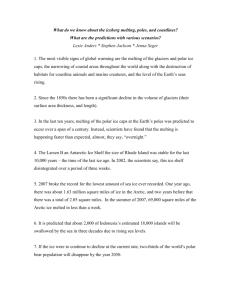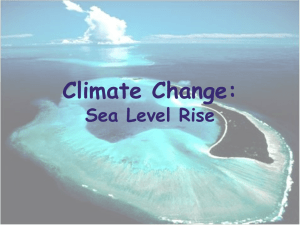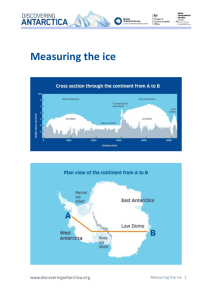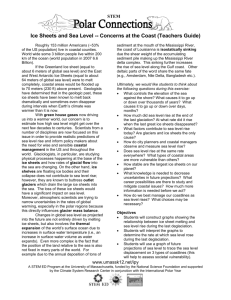Ice Sheets, Sea Level Rise, and Positive Feedbacks
advertisement
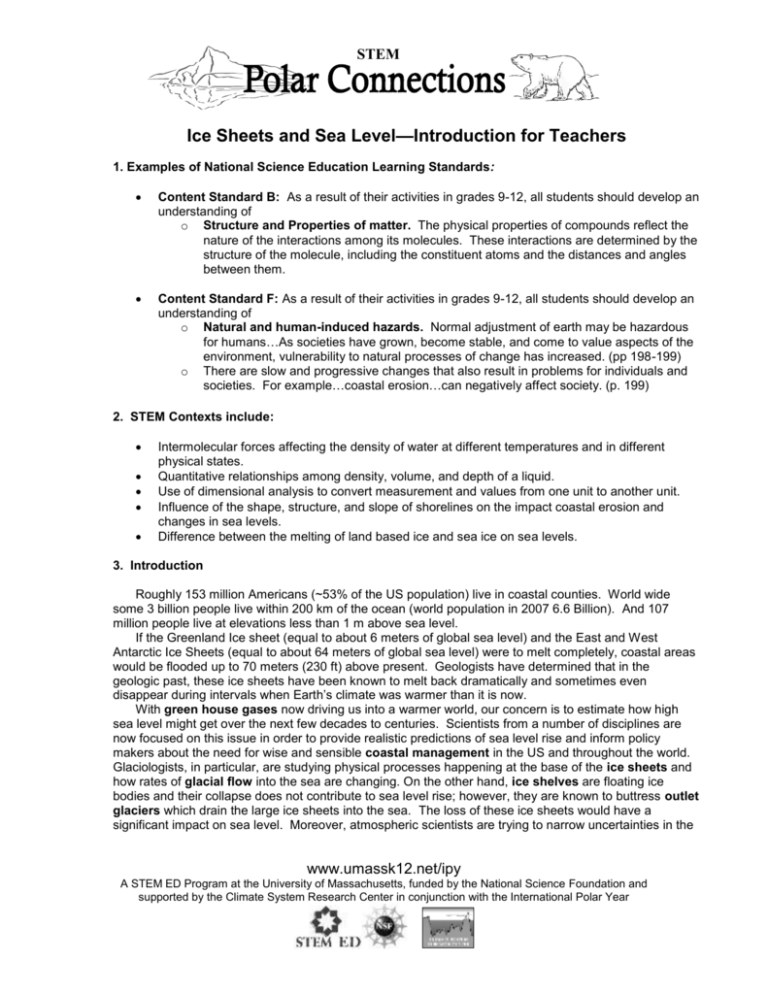
STEM Ice Sheets and Sea Level—Introduction for Teachers 1. Examples of National Science Education Learning Standards: Content Standard B: As a result of their activities in grades 9-12, all students should develop an understanding of o Structure and Properties of matter. The physical properties of compounds reflect the nature of the interactions among its molecules. These interactions are determined by the structure of the molecule, including the constituent atoms and the distances and angles between them. Content Standard F: As a result of their activities in grades 9-12, all students should develop an understanding of o Natural and human-induced hazards. Normal adjustment of earth may be hazardous for humans…As societies have grown, become stable, and come to value aspects of the environment, vulnerability to natural processes of change has increased. (pp 198-199) o There are slow and progressive changes that also result in problems for individuals and societies. For example…coastal erosion…can negatively affect society. (p. 199) 2. STEM Contexts include: Intermolecular forces affecting the density of water at different temperatures and in different physical states. Quantitative relationships among density, volume, and depth of a liquid. Use of dimensional analysis to convert measurement and values from one unit to another unit. Influence of the shape, structure, and slope of shorelines on the impact coastal erosion and changes in sea levels. Difference between the melting of land based ice and sea ice on sea levels. 3. Introduction Roughly 153 million Americans (~53% of the US population) live in coastal counties. World wide some 3 billion people live within 200 km of the ocean (world population in 2007 6.6 Billion). And 107 million people live at elevations less than 1 m above sea level. If the Greenland Ice sheet (equal to about 6 meters of global sea level) and the East and West Antarctic Ice Sheets (equal to about 64 meters of global sea level) were to melt completely, coastal areas would be flooded up to 70 meters (230 ft) above present. Geologists have determined that in the geologic past, these ice sheets have been known to melt back dramatically and sometimes even disappear during intervals when Earth’s climate was warmer than it is now. With green house gases now driving us into a warmer world, our concern is to estimate how high sea level might get over the next few decades to centuries. Scientists from a number of disciplines are now focused on this issue in order to provide realistic predictions of sea level rise and inform policy makers about the need for wise and sensible coastal management in the US and throughout the world. Glaciologists, in particular, are studying physical processes happening at the base of the ice sheets and how rates of glacial flow into the sea are changing. On the other hand, ice shelves are floating ice bodies and their collapse does not contribute to sea level rise; however, they are known to buttress outlet glaciers which drain the large ice sheets into the sea. The loss of these ice sheets would have a significant impact on sea level. Moreover, atmospheric scientists are trying to narrow uncertainties in the www.umassk12.net/ipy A STEM ED Program at the University of Massachusetts, funded by the National Science Foundation and supported by the Climate System Research Center in conjunction with the International Polar Year STEM rates of global warming, especially in the polar regions because this directly influences glacier mass balance. Changes in global sea level as projected into the future are not entirely driven by melting ice sheets, but also involve the thermal expansion of the world’s surface ocean due to increases in surface water temperature (i.e., an increase in surface water volume as water expands). Even more complex is the fact that the position of the land relative to the sea is also not fixed in many parts of the world. For example due to the annual deposition of tons of sediment at the mouth of the Mississippi River, the coast of Louisianna is isostatically sinking due the shear weight of the accumulating sediment pile making up the Mississippi River delta complex. This sinking further increases the rise of sea level along the Gulf coast. Other deltaic parts of the word share the same fate (e.g., Amsterdam, Nile Delta, Bangladesh etc.). In other regions, such as New England, the coast is still isostatically rising, in response to the unloading of ice sheets 15-20,000 years ago. The future rise in sea level along all coasts is a balance between the overall global sea level changes, and the local coastal changes. 4. Suggested Activities: A. Melting Ice and Sea Level—Demonstration B. Ice Sheets and Sea Level – Visualization of Sea Level Rise C. Ice Sheets and Sea Level—Graphs and Maps D. Thermal Expansion of Seawater—an Experiment 5. Relevant Links http://www.realclimate.org http://tidesandcurrents.noaa.gov/sltrends/sltrends.shtml http://coastalmanagement.noaa.gov/czm/czma_vision.html http://www.ipcc.ch/ipccreports/ar4-wg1.htm (especially chapter 5) http://www.pik-potsdam.de/~stefan/Publications/Nature/rahmstorf_science_2007.pdf http://www.coastalplanning.net/ http://flood.firetree.net/?ll=43.3251,-101.6015&z=13 https://www.cresis.ku.edu/research/data/sea_level_rise/ http://atmoz.org/blog/2007/10/31/sea-level-rise-due-to-thermal-expansion/ http://www.rd.com/your-america-inspiring-people-and-stories/kivalina-alaska-a-melting-village/article98947.html http://www.geo.arizona.edu/dgesl/research/other/climate_change_and_sea_level/sea_level_rise/sea_leve l_rise_old.htm#images http://www.northland.cc.mn.us/biology/Biology1111/animations/hydrogenbonds.html http://www.chemguide.co.uk/atoms/structures/molecular.html#top http://hypertextbook.com/physics/thermal/expansion/ www.umassk12.net/ipy A STEM ED Program at the University of Massachusetts, funded by the National Science Foundation and supported by the Climate System Research Center in conjunction with the International Polar Year




